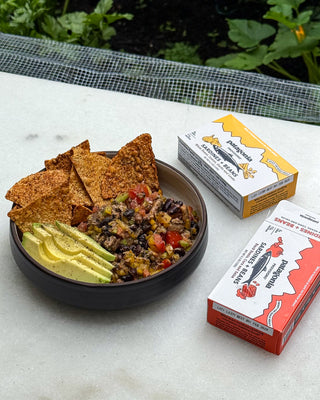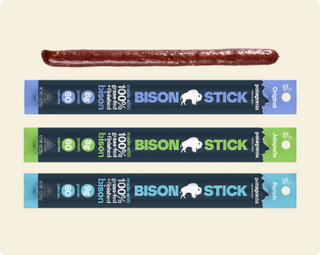Photo by Amy Kumler
The nutritional benefits of sourcing our bison from the Great Plains begins with allowing the animals to thrive on their natural diet. We produce the only 100% grass-fed and grass-finished bison stick available today. Our bison are never fed grain. Instead, they are pasture-raised across 500,000 acres of their native prairie and humanely harvested. This is a drastic shift away from the harmful practices of most commercially raised meat.
The nutritional benefits that come from raising bison to the highest possible standards are apparent when compared to other traditional meats and grain-fed bison. Here’s a scorecard that highlights where our bison stick offers far more optimal nutrients as compared with other red meat:

Photo by Andrew Burr
Why Bison?
Protein to Calorie Ratio
Our bison stick is packed with between 8 and 9 grams of protein and just 60 calories whereas beef, poultry, and pork-based sticks all offer less optimal protein-per-calorie ratios.
Grass-Finished vs Grain-Fed
Today 90% of bison and 98.5% of beef raised for food is grain-fed . This includes many products claiming they are “grass-fed” , which neglect to mention that they are not grass-finished, meaning that the animals still partially receive a diet of grain. We are the only brand offering bison sticks that are 100% grass-fed and finished. Our bison never taste grain or pesticides and are never administered antibiotics or hormones. This all-grass diet leads to meat that’s richer in vitamins, minerals and antioxidants, as well as polyphonic compounds, tocopherols, and carotene to support cellular health. By comparison, pen-raised, grain-fed buffalo are shown to build up harmful compounds such as triglycerides linked to heart disease.
Omega-3 vs. Omega-6 Fatty Acids
A lower omega-6 to omega-3 ratio means you're getting more omega-3s compared to omega-6s. That’s a good thing! Omega 3’s are essential to reducing inflammation, as well as supporting heart health, brain function, and overall wellness. Obtaining omega-3's from one's diet is essential because the human body cannot produce them on its own. Grass-fed bison boast substantial omega-3’s because the prairie grasses they feast on are full of them, whereas the grain-fed diet of conventionally raised beef results in higher omega-6’s, which is known to promote inflammation.
Leaner Meat With More Nutrient
100 grams of bison meat contains just 109 calories and 1.8 grams of fat, according to the USDA’s Agricultural Research Service. This makes bison naturally much leaner than the same amount of beef, which contains 291 calories and 24 grams fat. A diet free of antibiotics, pesticides, and added hormones also produces delicious, lean red meat rich in protein, iron, and vitamin B-12. The meat has less saturated fat and more potassium than grain-fed bison, as well as less fat and calories than conventional grain-fed beef.
Quality Ingredients & Low Sugar
No preservatives, fillers, nitrates, or artificial flavoring of any kind in our bison sticks. Just real simple ingredients with less than 2 grams of sugar per 1-ounce meat stick.





